Pierre Frey
Wallpapers
Kasuri
FP050002 - Pluie
Originally from Indonesia, the term ikat comes from the verb mengikat, which means "to bind". Initially, ikats were made with a warp, the skeins of wh...
Kasuri
Originally from Indonesia, the term ikat comes from the verb mengikat, which means "to bind". Initially, ikats were made with a warp, the skeins of which were first bound and dyed to give the pattern a blurred effect. Here, this pattern of irregular squares is called KASURI, which means "ikat" in Japanese. It is printed on a warp and then laminated on a non-woven backing. This type of design is familiar from Central and East Asian productions, as well as from China, where it seems to have developed around the 6th century.
Caractéristiques
Sales Unit
Available per meter/yard
Caractéristiques
Backing
NON WOVEN
Caractéristiques
Composition
70 % Cotton - 30 % Polyester
Caractéristiques
Width
126 cm / 49,60 inch
You want to add this product to your wishlist ?
Login or create an account
Scenography

Raccord : Vertical 39 cm / 15.35 inch
Raccord : Horizontal 42 cm / 16 inch
Laize : 126,00 cm / 49,60 inch
Technical sheet
Kasuri
FP050002 - Pluie
Pierre Frey - Soleil Levant
Type
Wide width printed wallpapers - Paperbacked fabrics
Sales Unit
Available per meter/yard
Backing
NON WOVEN
Composition
70 % Cotton - 30 % Polyester
Width
126 cm / 49,60 inch
Repeat
H: 42 cm - 16,00 inch
V: 39 cm - 15,35 inch
Straight repeat
Weight
330 gr / m²
Care
 Clean gently with a vacuum cleaner
Clean gently with a vacuum cleaner
 Moderate lightfastness
Moderate lightfastness
Trimming
Trimmed
Hanging/Removing
Paste the wall
Strippable
Certifications
ASTM E84 Class A
Information
Panel effect
Book
F9979PPFREY44
Download documents
Download here your maintenance guide or the different color charts by clicking on the corresponding buttons below:
colors
You want to add this product to your wishlist ?
Login or create an account
colors
You want to add this product to your wishlist ?
Login or create an account
colors
You want to add this product to your wishlist ?
Login or create an account
colors
You want to add this product to your wishlist ?
Login or create an account
colors
You want to add this product to your wishlist ?
Login or create an account
colors
You want to add this product to your wishlist ?
Login or create an account
You want to add this product to your wishlist ?
Login or create an account
You want to add this product to your wishlist ?
Login or create an account
colors
You want to add this product to your wishlist ?
Login or create an account
You want to add this product to your wishlist ?
Login or create an account
colors
You want to add this product to your wishlist ?
Login or create an account
colors
You want to add this product to your wishlist ?
Login or create an account
colors
You want to add this product to your wishlist ?
Login or create an account
You want to add this product to your wishlist ?
Login or create an account
You want to add this product to your wishlist ?
Login or create an account
colors
You want to add this product to your wishlist ?
Login or create an account
colors
You want to add this product to your wishlist ?
Login or create an account
You want to add this product to your wishlist ?
Login or create an account
colors
You want to add this product to your wishlist ?
Login or create an account
colors










































